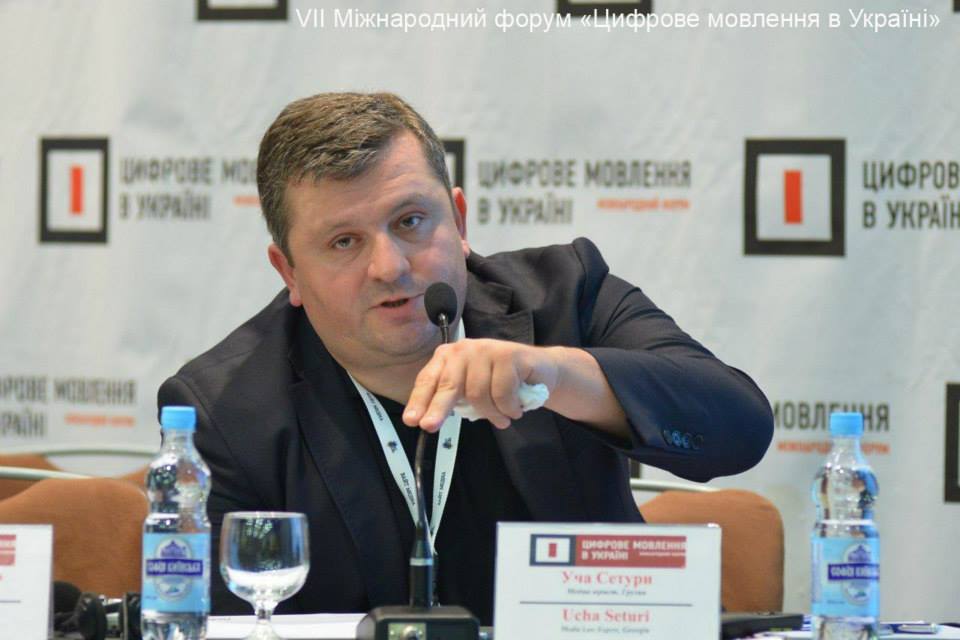On 12-18 September, 2013, the media and telecommunications expert from NNEL “Institute for Development of Freedom of Information” - Ucha Seturi, who is working on the project of transition of Georgia to digital terrestrial broadcasting and had published a number of studies and recommendations regarding this topic, participated in a conference held within the frameworks of the Ukrainian Media Week, invited by the Ukrainian Broadcasters Association. In his presentation the expert from IDFI presented information about the process of transition of Georgia to digital terrestrial broadcasting. The presentation focused on problematic issues and the challenges the country is facing in regards to regional and local broadcasters.

Ukraine started the process of transition to digital terrestrial broadcasting several years ago, while switching off analogue broadcasting is planned for 2015, similar to Georgia. Despite steps taken towards the goal, the problem of putting regional and local broadcasters into the network remains because of the high tariff for joining the main broadcasting, i.e. multiplexor. According to the participants of the meeting, the abovementioned problems are caused by the absence of political will. The main challenge of transition to digital broadcasting is the threat to media pluralism, since it reduces the survival chances of low-budget regional and local media outlets.
Regardless of who will be the owner of the digital network, in the case of his protection from competitors, he will have perfect conditions for creating an exclusive network and will have responsibilities, with which he will be able to effectively trader with the government, especially on such socially sensitive issues like the financing of receivers and, most importantly, their distribution-setup. This issue is even more critical in the context of the elections of the local self-governments.
Vertically integrated monopolists protected from competition are undesirable on the wholesale market, on which the fate of the media outlets of the country is 100% dependant, which was evident from the example of Ukrainian practice. Because of lack of alternatives, the content producers might be limited in different ways, for example with discriminatory and nontransparent conditions; however, according to the Ukrainians, the most important problem is still the issue of tariffs.
According to our information, the example of Tanzania is though-inducing as a unique case. The Regulatory Commission, despite pressure, managed to reduce the tariffs of the multiplex operator several times for assurance of orientation on expenses. Ukraine, where, despite great turmoil and arguments, the problem has not been solved, has so far been unable to do this.
During the heated arguments regarding this issue, the representative of the Ukrainian Tele-Radio Broadcasting National Council (the regulatory body of broadcasting) specifically noted that this issue has no political subtext and only touched the high cost of technical expenses. On the other hand, according to the opinion of the vast majority of those in attendance, the issue cannot be solved exactly because of political reasons, while the tariff has increased about five times. The claim, with relevant calculations and justification, has been presented to the Regulatory Commission and the Antimonopoly body, but there have been no results so far, and the perspectives are vague.
The broadcasters of Ukraine engage into the only and “expensive” network at the cost of unclear compromises. In the last period it has become known that a 70% discount on the access tariff has been observed.
In Ukraine, the access tariffs to regional multiplexors differ according to regions, which is logical considering the fact that it depends on the size of the coverage area. For example, the Odessa and Chernivicki districts can be brought as the smallest and biggest regions, respectively. In the Chernovicki district (which is only slightly bigger than the Imereti region in terms of population and size) the price of broadcasting a channel is 32 500 Grivna (3900 USD) a month and about 50 000 USD a year. As for the Odessa district (the territory and population of which is almost half of those of Georgia), the tariff is 200 000 Grivna (25 000 USD) a month, or approximately 300 000 USD a year.
Doubtless, a large number of these risks are present in Georgia too. The income of the regional broadcasters of Georgia is small, and considering the fact that the highest point in Odessa is 281 meters, coverage of the mountainous area of Georgia will be much more expensive for objective reasons.



